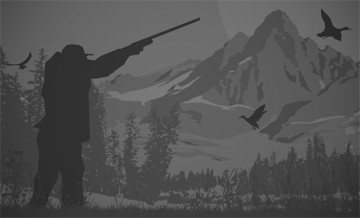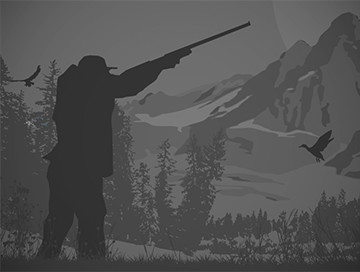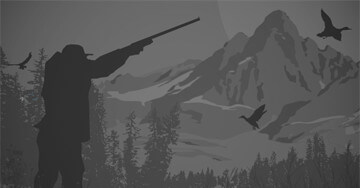Stalking on map
About Stalking
Stalking is generally considered the ultimate and the most sporting type of big-game hunting. It is as essential as it gets. The animal does not come to you because of hunger, thirst or urge to reproduce. It is not pushed to you by drivers, the dogs don't distract the animal's attention, and your scent is not carried over its nostrils by your position on a high seat. It's only you and your prey: your knowledge and skills of coming into range against the animal's five senses and ability to detect danger, fine-tuned by millennia of natural selection. Read more...
To stalk an animal, you have to see it before it sees you, so stalking usually begins with "glassing", or examining the area through optics. This makes stalking the method of choice for trophy hunters, because they can examine the potential trophy size first thing, and not waste time chasing an inferior animal. You use the advantages of available foliage, terrain and wind to come into range for a shot without alerting the animal, and often have to go on your knees or even crawl. Approaching the animal in this manner can be very emotional, because you get to see the quarry much of the time during the stalk. Most outfitted stalking hunts involve a professional guide, often called "stalker", who helps you navigate through strange terrain and find the animal of your choice. In most cases, the guide will stalk the animal with you, so that if you're not certain what to do you can simply follow the stalker's every move. A novice hunter can learn a whole lot from an experienced stalker, but as you get experience you'll most likely want to do it all by yourself. Whether the guide will allow it or not depends on the guide's estimation of your ability, legality, wariness of the animal (two are always more conspicuous than one), and potential risks of your running into trouble from dangerous game or terrain while the guide is too far to come to your rescue. Stalking is usually practiced in country that is reasonably open, and yet features some objects that allow you to hide behind, such as trees, rocks, anthills, ravines and such. In densely wooded areas stalking often evolves into still-hunting, when you walk through the grounds slowly and carefully, often stop to listen and hope you will see your quarry first, or at least have an opportunity for a shot as it makes its escape. On the flat open ground stalking will invariably involve crawling on your knees and may evolve into slithering on your stomach. To approach a wary animal, you must be thinking strategically. The animal’s position, the position of the sun, wind direction, and the animals movements all must be taken into consideration. A front-end approach will often fail, where a slightly round-about way will succeed. Most beasts will be less alarmed if you don't come up straight to them, but will be moving to a spot to the right or to the left of them. Everyone knows that you should approach your quarry downwind. But dwellers of open planes rely on their eyes even more than on their sense of smell. If there's an opportunity of having the sun at your back, or even a minor bit of cover - a random bush, a slight ravine - that could possibly shield you from their vision, it's usually better to make a long detour to take advantage of it. Anyone who goes stalking should be prepared to shoot at the maximum range as your particular weapon will permit in case you run out of cover on your approach. However, a long shot should be taken only at the last resort - you must make every attempt to approach as close as possible. Many things that seem impossible become quite doable when there's no way out, and quite a few hunters can stalk even animals as wary as mountain goats or the ever on alert whitetail deer to get close enough for an ethical shot even with a bow or handgun. What makes many hunters prefer stalking for an outfitted hunt is that it requires the client to be skillful and competent like no other way of taking big game. Your success always depends partly on your actions, and partly on the outfitter's, but other than hunting on your own, no other way of hunting is so much up to your abilities and skill. To begin with, you must be fit enough to take a lot of walking. Some outfitters simplify things by covering terrain in vehicles or on horseback, and only make the final approach to the animals on foot. Still, it happens as often as not that as you come nearer your quarry, it moves away from you, and there is no telling where the pursuit will take you. When it's time for a shot, the beast may well be miles away from the nearest spot accessible by a vehicle. You must also be ready to withstand the exposure to the elements. If a thunderstorm or blizzard catches up with you mid-hunt, there's usually nowhere to hide. Sometimes during a stalk you have to keep still for a long time, so as not to let the animal see you, and in full accordance to Murphy's law, it's usually in the most uncomfortable posture or environment - e.g., standing knee deep in a mountain stream as cold as the glacier it flows from or kneeling in mud or on thorn strewn ground. A successful stalk depends not only about knowing how to hide, how to move without any sound and in the most inconspicuous manner. It also requires you to be very observant, use all of your senses and know the animal's behavior well. The rule of thumb is, move when the beast doesn't suspect anything, freeze and wait if it behaves as if something alerts it. A classic example is stalking a feeding herbivore: head down - animal feeding - you move. Head up - animal on the alert - you freeze. Even when you simply follow a professional stalker, mimicking his every move, you can't succeed without your own knowledge and ability to make quick decisions. Often, the split second that it takes you to realize that the guide has stopped is enough to spook your quarry. You must anticipate what the next step will be before the guide makes his, and that's where your observation, your instincts and your knowledge come to play. This all makes stalking perhaps the most sportive and rewarding method of hunting. By the time you finally get your trophy, you will usually have invested so much knowledge, fatigue, resistance of elements, and challenging shooting conditions, that a simple recollection of your experience will be enough to silence any "it's only about shooting innocent defenseless creatures" theory proponent. Explore your opportunities of stalking with BookYourHunt. Hide details
Interested in Stalking trips? Create a subscription to get offers right to your inbox




